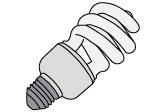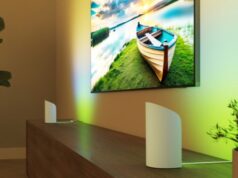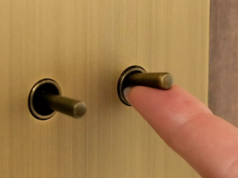
These lamps are more efficient, readily available and burn far cooler that conventional incandescents and halogen globes.

Compact fluorescent lamps (CFLs) have been designed and widely accepted as an energy efficient alternative to traditional incandescent light globes, and can fit directly into existing bayonet cap (BC) and Edison screw (ES) light fixtures. While they are typically used as diffuse lights, they can also be used in directional downlights as energy efficient replacements for halogen globes.
How CFLs work
Compact fluorescent lamps (CFLs) work in the same way traditional fluorescent tube lighting does. In a nutshell, a current is passed through a tube filled with argon gas and mercury vapour, which is coated with a phosphor coating. When the mercury vapour is excited, it releases energy in the form of ultraviolet light, which then reacts with the phosphor coating to emit light from the globe that is visible to the human eye.
Click here for a more detailed technical description about how fluorescent globes work.
Cost savings over incandescents
Typically, a CFL costs more to buy than an equivalent incandescent lamp might have, but can save approximately $30-$40 in electricity costs over the lamp’s lifetime. Much of this saving is related to the longer average rated life of CFLs. Where an incandescent globe will last just 750-1,000 hours, a CFL can last between 6,000 and 15,000 hours. Savings are also made in terms of how much energy is consumed. While it’s true that CFLs cost more to buy than traditional incandescents, the investment is outweighed by the fact that they use only 20% of the electricity consumed by a standard light globe.
To break it down: a typical 15W CFL, which is equivalent in terms of light output to a 75W incandescent globe, costs around $5 to buy. So replacing an incandescent or halogen downlight with a CFL globe can save up to 80% on running costs. Savings of around $300 per year can be achieved by using 10 energy efficient CFL lights instead of 40 standard 50W halogen downlights. Cheaper again, though, are LED lamps, which cost considerably more to buy but last far, far longer and consume much less electricity.
Common issues
CFLs aren’t without their flaws though. One problem with CFLs is lumen depreciation, which means that as the globe gets older, it is capable of producing less light. Cheaper CFLs typically experience faster lumen depreciation than their counterparts, but higher quality models generally lose no more than 20% of their initial lumens over their 15,000-hour life.
Likewise, another problem with some of these lights is slow warm-up times. This was not an issue for incandescent bulbs, but some CFLs can take up to one minute to warm up to full brightness.





